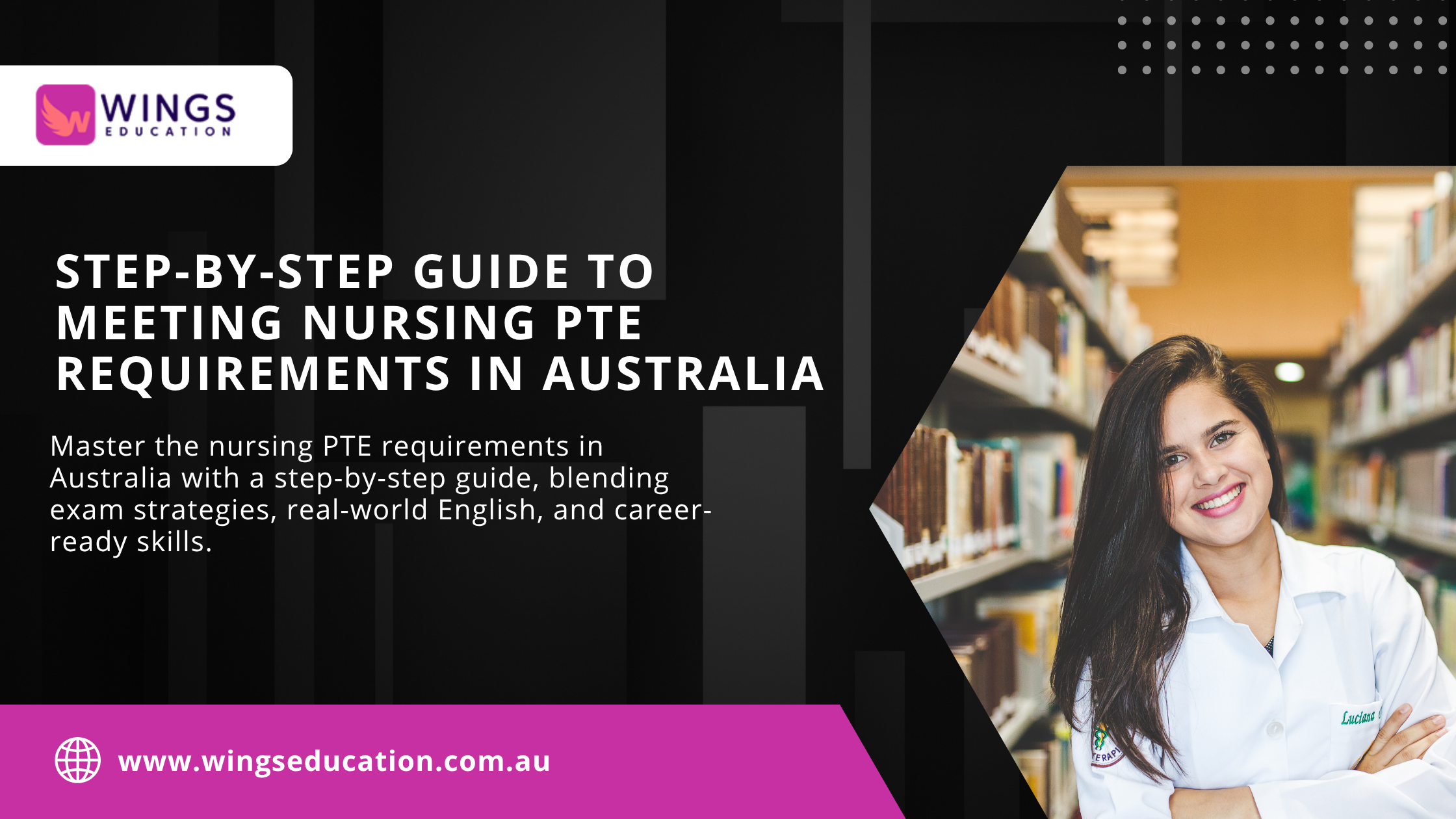
Step-by-Step Guide to Meeting Nursing PTE Requirements in Australia
Master the nursing PTE requirements in Australia with a step-by-step guide, blending exam strategies, real-world English, and career-ready skills.
For internationally educated nurses, mastering English is not just a requirement—it is the key to ensuring patient safety, effective communication, and professional integration in Australia. In 2025, the landscape of language testing for nurses has evolved, and understanding nursing PTE requirements in Australia has never been more critical. The Pearson Test of English (PTE) serves as the benchmark for assessing whether nurses can communicate confidently, accurately, and efficiently in clinical settings. Successfully navigating this requirement opens doors to registration, employment, and career growth in Australia’s healthcare system.
The challenge, however, is not merely academic. Many nurses are highly skilled in their field but find that test conditions, unfamiliar accents, or exam-specific techniques can become obstacles. Meeting the nursing PTE requirements in Australia involves more than memorizing vocabulary; it requires a strategic, step-by-step approach that integrates skill-building, practical application, and confidence enhancement.
Understanding Nursing PTE Requirements in Australia
Before beginning preparation, it is essential to understand what the nursing PTE requirements in Australia entail. For AHPRA (Australian Health Practitioner Regulation Agency) registration, nurses must demonstrate proficiency in English through standardized testing. The PTE evaluates four core skills: speaking, writing, reading, and listening. Each module assesses specific abilities: clarity of speech, coherence in writing, comprehension of academic and clinical texts, and understanding spoken instructions in various accents.
The requirements are precise. A common standard is a minimum overall score of 65, with no sub-score lower than 50, though these figures may vary depending on the applicant’s category or registration pathway. Understanding these benchmarks early allows candidates to plan their preparation efficiently and focus on areas needing the most improvement.
The First Step: Self-Assessment
Every journey begins with self-awareness. Assessing your current level of English proficiency is critical. Many nurses underestimate their abilities or, conversely, overestimate them based on daily conversational English. A comprehensive self-assessment identifies strengths, weaknesses, and potential challenges.
Start by taking a diagnostic test or a mock PTE. These exercises simulate the test environment, revealing your timing, stress responses, and performance across different modules. A detailed analysis of results highlights which areas—speaking, writing, listening, or reading—require intensive focus.
Self-assessment is more than just testing—it sets the foundation for a structured study plan, helping you allocate time and resources effectively to meet the nursing PTE requirements in Australia.
Crafting a Strategic Study Plan
Once strengths and weaknesses are identified, the next step is creating a strategic study plan. Random practice is rarely effective. Instead, preparation should be structured, goal-oriented, and flexible enough to adapt to progress over time.
Effective study plans divide time between the four modules, with extra emphasis on weaker areas. For example, if writing complex sentences or summarizing clinical texts is challenging, allocate additional sessions to essay writing and paraphrasing. Similarly, if listening comprehension under pressure is difficult, practice with multiple English accents—Australian, British, Indian, and others—to simulate real-world scenarios.
Integrating short-term goals (e.g., improving listening scores by 10 points in two weeks) and long-term milestones (e.g., achieving overall eligibility for registration) keeps preparation focused and motivating. The structured approach also reduces anxiety, as each day has a clear purpose and measurable outcome.
Building Core Language Skills
The heart of meeting the nursing PTE requirements in Australia lies in strengthening core language skills. Speaking, writing, listening, and reading are interconnected, and improvement in one area often benefits others.
Speaking
Speaking confidently is essential, particularly for nurses who must communicate with patients, families, and colleagues. In preparation, focus on clarity, intonation, and vocabulary accuracy. Practicing clinical dialogues, describing procedures, or explaining medical concepts aloud helps simulate real-world application. Recording your speech and reviewing it critically also builds self-awareness and highlights areas for improvement.
Writing
Writing exercises should go beyond essay practice. Nurses often encounter reports, patient notes, and emails in professional contexts. Practicing structured writing, summarizing complex texts, and organizing thoughts coherently enhances both exam performance and practical readiness. Pay attention to grammar, punctuation, and logical flow—skills that are vital for patient safety and documentation accuracy.
Listening
Listening exercises should include authentic audio sources such as lectures, patient instructions, and conversations between healthcare professionals. Exposure to multiple accents, speech speeds, and terminologies sharpens comprehension and prepares you for the varied language encountered in clinical environments. Active listening techniques—taking notes, predicting content, and identifying key points—are particularly effective.
Reading
Reading comprehension involves quickly understanding information from diverse texts. Practice analyzing academic articles, clinical guidelines, and patient instructions. Focus on skimming for main ideas, scanning for details, and drawing inferences. These strategies enhance both exam performance and workplace readiness.
Leveraging Mock Tests Effectively
Mock tests are not merely practice—they are diagnostic and confidence-building tools. At this stage, it is essential to integrate them strategically into your preparation rather than using them randomly.
Take full-length mock exams under timed conditions to simulate the pressure of the real test. Afterward, review each response critically. Identify patterns of mistakes: Are they due to time management, misunderstanding instructions, or knowledge gaps? Correcting these systematically is key to improvement.
Incorporating regular mock tests also builds stamina and resilience, helping nurses remain calm and focused during the actual exam. Consistent evaluation ensures that preparation aligns with the nursing PTE requirements in Australia, minimizing surprises on test day.
Developing Test-Taking Strategies
While language proficiency is critical, knowing how to approach the test strategically can significantly enhance performance. Effective strategies include:
- Managing time efficiently across sections to avoid last-minute pressure.
- Prioritizing questions according to strengths to maximize scoring potential.
- Practicing paraphrasing and summarizing to improve writing scores.
- Engaging in structured speaking exercises to maintain fluency under timed conditions.
These strategies complement core skills and ensure that exam performance reflects actual ability rather than panic or mismanagement.
Stress Management and Mindset
Test anxiety is a common barrier for many nurses, even highly proficient English speakers. Psychological preparation is as important as skill-building. Mindfulness exercises, visualization, and breathing techniques help maintain focus and reduce stress.
Approach the exam with a mindset of opportunity rather than threat. Each question is a chance to demonstrate competence, not a hurdle to fear. Confidence gained through consistent practice and mock tests translates into calmer, more effective performance.
Leveraging Professional Guidance
Guidance from experienced trainers or language coaches can accelerate progress. They provide insights into exam patterns, common pitfalls, and effective strategies tailored to nursing contexts. Personalized feedback ensures that preparation is focused on areas that yield the greatest improvement.
Additionally, peer learning and discussion in structured group sessions simulate real-world interactions, reinforcing both linguistic and professional skills. Collaboration exposes learners to varied perspectives, accent differences, and communication styles that reflect clinical environments.
Practical English for Nursing Beyond the Exam
Meeting nursing PTE requirements in Australia is not solely about the exam—it is about preparing for effective communication in healthcare settings. Nurses must interact with patients, families, and colleagues with clarity and empathy.
Practical exercises, such as explaining procedures, summarizing patient history, or delivering oral reports, bridge exam preparation and professional competence. Developing these skills ensures that passing the PTE translates into meaningful workplace performance, fostering patient safety and confidence in professional interactions.
Tracking Progress and Adjusting the Plan
Continuous monitoring is crucial. Track scores, analyze mistakes, and adjust your study plan accordingly. Focus on incremental improvements rather than expecting perfection immediately. Small, consistent gains accumulate over time, ensuring readiness by test day.
Adaptive learning allows you to allocate more time to weaker areas while maintaining strengths. This balance ensures that you meet the nursing PTE requirements in Australia efficiently and with confidence.
Test Day Preparation
Preparation extends to the day of the test. Arrive early, stay hydrated, and review key strategies calmly. Familiarity with exam format reduces anxiety and allows focus on execution. Remember that preparation over weeks and months is what carries you through the exam, not last-minute cramming.
Confidence on test day reflects the effort invested in practice, skill-building, and mock tests. By approaching the exam with composure, candidates demonstrate not only language proficiency but also the professional maturity expected of nurses.
Beyond PTE: Career Readiness
Achieving the required PTE score is a milestone, but it is also a stepping stone to a rewarding nursing career in Australia. Language proficiency enhances not only registration eligibility but also effectiveness in clinical environments, teamwork, and patient care.
Nurses who integrate exam preparation with real-world English skills enter the workforce ready to communicate clearly, document accurately, and collaborate efficiently. The nursing PTE requirements in Australia thus serve a dual purpose: ensuring competency for registration and fostering long-term professional success.
Final Thoughts
Meeting the nursing PTE requirements in Australia in 2025 requires a strategic, holistic approach. From self-assessment to mock tests, skill-building, personalized plans, and stress management, each step contributes to success. The process is not just about passing a test; it is about developing confidence, practical English skills, and professional competence.
By combining disciplined preparation with real-world application, nurses can transform the challenge of PTE into an opportunity for growth, career advancement, and excellence in patient care. For aspiring nurses, this journey is a critical foundation for both immediate goals and long-term success in Australia’s healthcare system.























